Dive into the Hive
...

Ready for another tour of our bees' hives?
We've been taking a slightly different approach to hive-inspections, meaning that we take the whole stack of boxes apart, and work from the bottom, up. We were finding that starting at the top made bees really agitated. We often weren't getting through the entire inspection, because the bees were getting so pissed off. Since the queen tends to lay eggs in the lower boxes, we get to see the status of brood production before the bees get too annoyed with us.
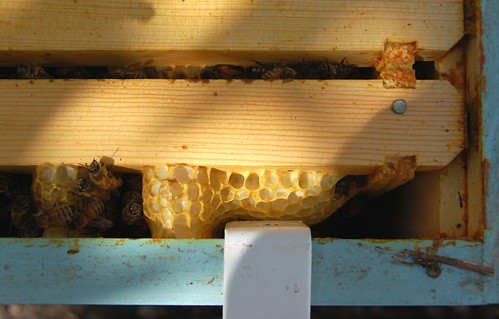
This is the first thing we saw when we opened the lowest box. Wax comb bridging between a frame and the hive wall. The bees seem determined to ignore the architecture of the hive, and have been building structures that span across the frames.

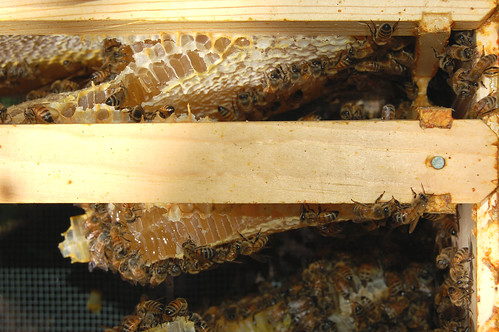
I'm not continually writing about this because I'm some sort of compulsive neat freak. (Stop laughing.) I keep coming back to this subject because when the bees build their wax in a way that spans more than one frame, the honeycomb gets torn to pieces when we move frames around. Ripping apart the honeycomb either kills bee pupae, or drowns bees in honey.
Either way, it's not good.
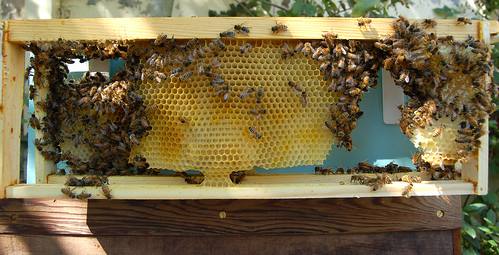
If you look closely at the comb on the right side of the frame, you can see how the top portion is ripped open. Honey is pouring out, which is wasteful, and destructive to the bees.
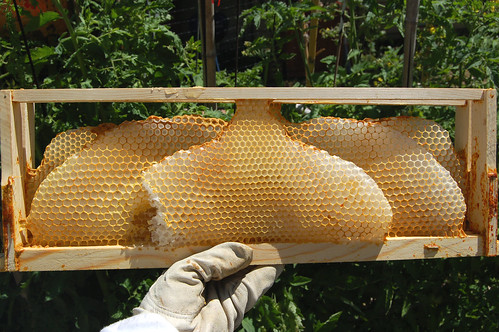
Although Robb and I intended to take a very hands-off approach to hive management, this had to be dealt with.
In the photo above, the bees have built three curved paddles of comb, spanning two frames. This was a mess in the making. It's hard to see, but the comb is concave, sort of like the headrest of a car's seat. We're really not sure why the bees favor this cupped form.
Robb and I decided to pull out the worst comb, harvesting any capped honey. We cut the conjoined frames apart, and gave everything a trim. Any cut-off comb that contained unripened nectar was set in a bucket, for the bees to remove. Hopefully, they'll get most of their nectar back into the hive before the ants discover the feast.

The next step was to inter-leaf messed-up comb with more regularly, straight comb. We alternated the weird comb with frames like this one. Nice, huh? The bees built all this beautiful comb over the past two weeks.
It's interesting to us, how the newest wax is so nice and white, while comb that has been the nursery for larvae and pupae gets darkened.
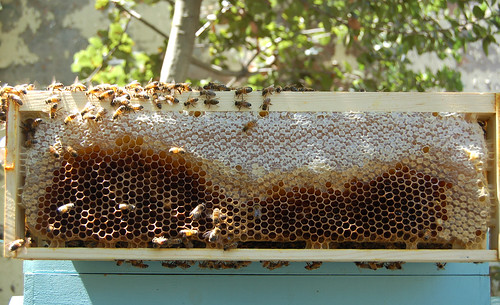
The actual brood nest changes position in the hive, over the course of the year, so wax comb can serve multiple functions. This frame -- which previously housed developing bees -- has honey on the top edge, and the bees are filling the lower section with unripened nectar.
We had to cut some of this darker comb out, because of its eccentric construction. When we melted it down in the solar melter, we were surprised how the darker interiors of the comb retained their honeycomb form after the clean wax had melted away.
The impurities left behind when one renders bees' wax is called slumgum. It is made up of the pupal cocoons, and other icky things, like dead bees and larval poop. Apparently the smell of this stuff is wildly enticing to bees, and some beekeepers melt it and apply it to empty hives in the hopes of attracting swarms. We'll probably compost ours. It is said to be good for the soil.
Some beekeepers leave brood wax in place for years on end. Others are concerned about the buildup of bee waste and agricultural chemicals, and try to cycle these frames out with some regularity. We'll be trying to remove the darkest, dirtiest wax from our hives, when the opportunity presents itself. That is to say, when the bees have moved the brood nest up or down in the hive, we'll take the opportunity to remove any empty brood comb.
Many people feel that this sort of hive hygiene discourages the build-up of pathogens. We figure it can't hurt to do a bit of house-keeping from time to time. Other feel that making the bees build comb expends energy that would otherwise be used to create honey. I'm fine with that trade-off. I'd rather that the bees had a clean home. How much honey can we eat, anyway?

Even though the wax has darkened, it's still incredibly thin. Do you see the sun streaming through the empty cells in the center of this brood comb?
I think it's amazing to think that bees build such a light -- yet strong -- structure out of the wax produced by their own tiny bodies.

Ready for another tour of our bees' hives?
We've been taking a slightly different approach to hive-inspections, meaning that we take the whole stack of boxes apart, and work from the bottom, up. We were finding that starting at the top made bees really agitated. We often weren't getting through the entire inspection, because the bees were getting so pissed off. Since the queen tends to lay eggs in the lower boxes, we get to see the status of brood production before the bees get too annoyed with us.

This is the first thing we saw when we opened the lowest box. Wax comb bridging between a frame and the hive wall. The bees seem determined to ignore the architecture of the hive, and have been building structures that span across the frames.

Like this.

And this.
I'm not continually writing about this because I'm some sort of compulsive neat freak. (Stop laughing.) I keep coming back to this subject because when the bees build their wax in a way that spans more than one frame, the honeycomb gets torn to pieces when we move frames around. Ripping apart the honeycomb either kills bee pupae, or drowns bees in honey.
Either way, it's not good.

If you look closely at the comb on the right side of the frame, you can see how the top portion is ripped open. Honey is pouring out, which is wasteful, and destructive to the bees.

Although Robb and I intended to take a very hands-off approach to hive management, this had to be dealt with.
In the photo above, the bees have built three curved paddles of comb, spanning two frames. This was a mess in the making. It's hard to see, but the comb is concave, sort of like the headrest of a car's seat. We're really not sure why the bees favor this cupped form.
Robb and I decided to pull out the worst comb, harvesting any capped honey. We cut the conjoined frames apart, and gave everything a trim. Any cut-off comb that contained unripened nectar was set in a bucket, for the bees to remove. Hopefully, they'll get most of their nectar back into the hive before the ants discover the feast.

The next step was to inter-leaf messed-up comb with more regularly, straight comb. We alternated the weird comb with frames like this one. Nice, huh? The bees built all this beautiful comb over the past two weeks.
It's interesting to us, how the newest wax is so nice and white, while comb that has been the nursery for larvae and pupae gets darkened.

The actual brood nest changes position in the hive, over the course of the year, so wax comb can serve multiple functions. This frame -- which previously housed developing bees -- has honey on the top edge, and the bees are filling the lower section with unripened nectar.
We had to cut some of this darker comb out, because of its eccentric construction. When we melted it down in the solar melter, we were surprised how the darker interiors of the comb retained their honeycomb form after the clean wax had melted away.
The impurities left behind when one renders bees' wax is called slumgum. It is made up of the pupal cocoons, and other icky things, like dead bees and larval poop. Apparently the smell of this stuff is wildly enticing to bees, and some beekeepers melt it and apply it to empty hives in the hopes of attracting swarms. We'll probably compost ours. It is said to be good for the soil.
Some beekeepers leave brood wax in place for years on end. Others are concerned about the buildup of bee waste and agricultural chemicals, and try to cycle these frames out with some regularity. We'll be trying to remove the darkest, dirtiest wax from our hives, when the opportunity presents itself. That is to say, when the bees have moved the brood nest up or down in the hive, we'll take the opportunity to remove any empty brood comb.
Many people feel that this sort of hive hygiene discourages the build-up of pathogens. We figure it can't hurt to do a bit of house-keeping from time to time. Other feel that making the bees build comb expends energy that would otherwise be used to create honey. I'm fine with that trade-off. I'd rather that the bees had a clean home. How much honey can we eat, anyway?

Even though the wax has darkened, it's still incredibly thin. Do you see the sun streaming through the empty cells in the center of this brood comb?
I think it's amazing to think that bees build such a light -- yet strong -- structure out of the wax produced by their own tiny bodies.

Comments
My bees have drawn their brood nest well up into the mediums, darn them. I'm not medium-rich enough -- we'll see what sort of harvest we get this year.
Using the straight comb to guide them is a good idea. In nature, they tend to curve. Something about depth by width that does it.
Overall, the bees are doing a beautiful job building comb. I'm only showing the weirdo combs. Most everything else is perfect.
As for why we don't use foundation... There have been a lot of studies (which I can't seem to put my hands on at the moment) showing that the wax used in commercial foundation has high concentrations of agricultural chemicals. It makes sense. The largest beekeepers in America are the commercial guys. Those beekeepers are also most likely to heavily medicate their bees, and also to place them in fields where they may be sprayed with all sorts of agro-chemicals. When that wax is sent to be turned into foundation, it's steeped in chemicals.
I'm really not strong enough to heft a full deep ten-frame box, and Robb can't either. So, we opted to have more smaller boxes.
And as for the ridiculous question, "How much honey can we eat, anyway?" may I rephrase to "How many of our friends, neighbors and (ahem) fellow bloggers want our honey?!"
(Actually kidding since I'm waiting for my hives to be ready, so perhaps we could do a swap when it comes time?)